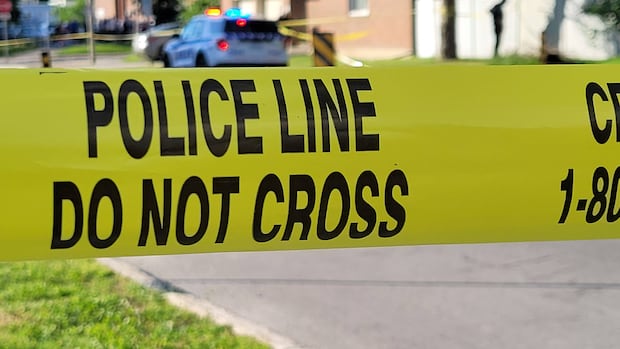OttawaThe Ottawa Police Service’s (OPS) crime clearance rate dropped to 26 per cent in 2024, the force revealed Wednesday in its submission asking for a significant budget increase.Police solved 26% of caseload in 2024, a significant drop from recent yearsListen to this articleEstimated 4 minutesThe audio version of this article is generated by text-to-speech, a technology based on artificial intelligence.Ottawa police investigate a crime scene in June 2024. The police service’s crime clearance rate dropped to 26 per cent that year. (Gabrielle Huston/CBC)The Ottawa Police Service’s (OPS) crime clearance rate dropped to 26 per cent in 2024, the force revealed Wednesday in its submission asking for a significant budget increase.The service is asking for more funding in part to help tackle an increasing volume of reported crime, which it says rose 63 per cent from 2015 to 2024, when 50,600 offences were committed.The crime clearance rate refers to the proportion of reported offences that result in charges. OPS said its clearance rate has dropped 10 per cent over the past decade, and is now the second lowest rate of the 12 largest municipalities by population in Ontario.”That is not surprising based on the population growth, based on the call volume that’s increased, based on the complexity of the files that we get,” Chief Eric Stubbs told CBC on Wednesday. “When you have more or less the same amount of people doing this work, something is going to slip and some of those solvency rates will slip because of that,” he said. “It’s certainly not a criticism of our team, but it’s a criticism of the bandwidth that is there for them to do their jobs.”Stats Can reports higher rateStatistics Canada meanwhile provides a 31 per cent weighted clearance rate for Ottawa in 2024, compared to 30.8 for Toronto, 33.83 for Hamilton and 32.12 for Kitchener. The overall provincial average is 38.75 per cent. The difference between the OPS rate of 26 per cent and the 31 per cent cited by Statistics Canada is due to “how the data is calculated,” an OPS spokesperson said Wednesday. The OPS rate “is calculated by total incidents cleared (by charge or otherwise) divided by the total reported incidents. The StatsCan clearance rate is a weighted result where some offences are assigned a higher ‘weight’ than other offences, and then the clearance rate is based on that,” the spokesperson said in an email to CBC. Irvin Waller says Ottawa can learn from proven strategies and models from around the world, including in Glasgow, Scotland. (Radio-Canada)Irvin Waller, professor emeritus of criminology at the University of Ottawa, cautioned that crime clearance rates are “fairly discretionary” in that police decide when they consider a crime solved, meaning standards may differ across jurisdictions. More importantly, improving the crime clearance rate would not address the causes of crime, Waller said.”If you increase the police budget, you should be able to respond to the increase in 911 calls and you should be able to clear more of the more severe offences. But you have to see this as a reaction to crime and not as a way of reducing crime,” he said.Violent crime on the riseWhile crime clearance rates include serious offences alongside minor ones, Waller said rising violence is the greatest concern. “The most important context is that violent crime has been increasing steadily [in Ottawa] over the last decade,” he said. “Ottawa has moved from a relatively low homicide rate, well below the national average, to a homicide rate closer to the national average.”OPS recorded 26 homicides last year, up from 13 in 2023 and a five-year average of 17.To address rising violence, Waller would like to see the budget increase requested by OPS directed toward “upstream” programs addressed at stopping crime before it’s committed.”The sorts of things that work are outreach to the young men most involved in violence,” he said, citing case studies in cities like Boston where he said outreach programs had successfully reduced violent crime. “When you look at those statistics, at the increases that have occurred over 10 years, yes, we may need more police to respond. But more than anything, we need the programs that will stop that violence,” he said. ABOUT THE AUTHORCampbell MacDiarmid is a reporter with the CBC Ottawa bureauWith files from Kate Porter
Thursday, 13 Nov 2025
Canada – The Illusion
Search
Have an existing account?
Sign In
© 2022 Foxiz News Network. Ruby Design Company. All Rights Reserved.
You May also Like
- More News:
- history
- Standing Bear Network
- John Gonzalez
- ᐊᔭᐦᑊ ayahp — It happened
- Creation
- Beneath the Water
- Olympic gold medal
- Jim Thorpe
- type O blood
- the bringer of life
- Raven
- Wás’agi
- NoiseCat
- 'Sugarcane'
- The rivers still sing
- ᑲᓂᐸᐏᐟ ᒪᐢᑿ
- ᐅᑳᐤ okâw — We remember
- ᐊᓂᓈᐯᐃᐧᐣ aninâpêwin — Truth
- This is what it means to be human.
- Nokoma












